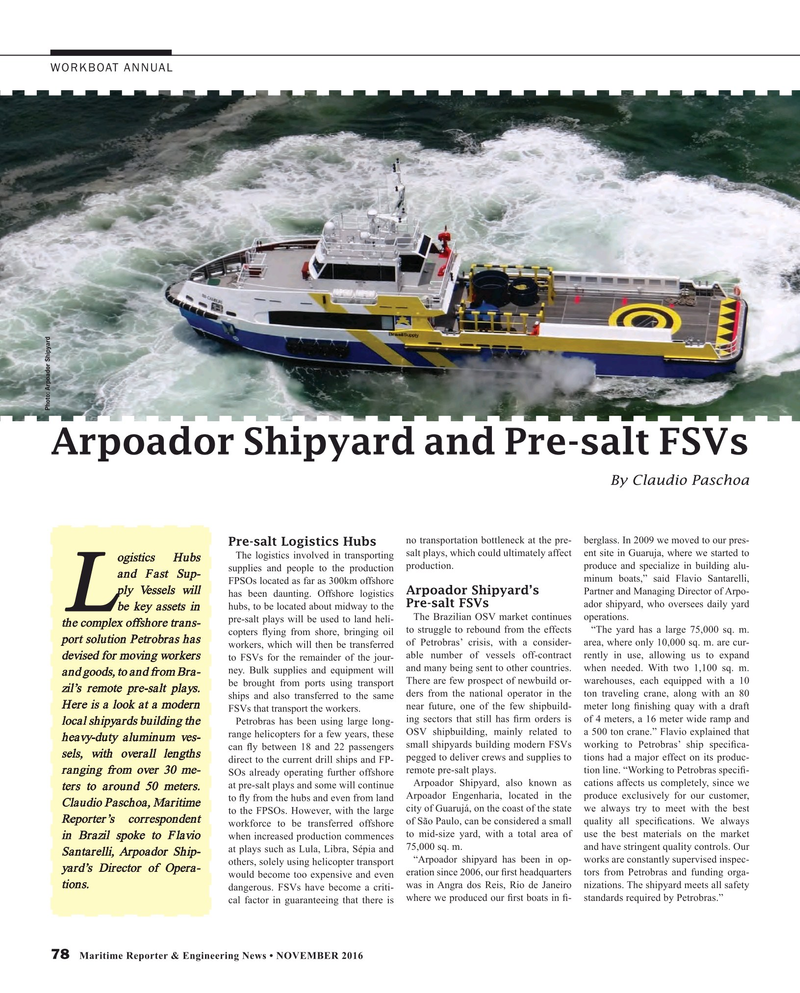
Page 78: of Maritime Reporter Magazine (November 2016)
Workboat Edition
Read this page in Pdf, Flash or Html5 edition of November 2016 Maritime Reporter Magazine
WORKBOAT ANNUAL
Photo: Arpoador Shipyard
Arpoador Shipyard and Pre-salt FSVs
By Claudio Paschoa no transportation bottleneck at the pre- berglass. In 2009 we moved to our pres-
Pre-salt Logistics Hubs
The logistics involved in transporting salt plays, which could ultimately affect ent site in Guaruja, where we started to ogistics Hubs supplies and people to the production production. produce and specialize in building alu- and Fast Sup- minum boats,” said Flavio Santarelli,
FPSOs located as far as 300km offshore ply Vessels will Arpoador Shipyard’s
Partner and Managing Director of Arpo- has been daunting. Offshore logistics ador shipyard, who oversees daily yard
Pre-salt FSVs hubs, to be located about midway to the be key assets in
L
The Brazilian OSV market continues operations. pre-salt plays will be used to land heli- the complex offshore trans- copters ? ying from shore, bringing oil to struggle to rebound from the effects “The yard has a large 75,000 sq. m. port solution Petrobras has workers, which will then be transferred of Petrobras’ crisis, with a consider- area, where only 10,000 sq. m. are cur- able number of vessels off-contract rently in use, allowing us to expand devised for moving workers to FSVs for the remainder of the jour- ney. Bulk supplies and equipment will and many being sent to other countries. when needed. With two 1,100 sq. m. and goods, to and from Bra- be brought from ports using transport There are few prospect of newbuild or- warehouses, each equipped with a 10 zil’s remote pre-salt plays. ships and also transferred to the same ders from the national operator in the ton traveling crane, along with an 80
Here is a look at a modern near future, one of the few shipbuild- meter long ? nishing quay with a draft
FSVs that transport the workers. ing sectors that still has ? rm orders is of 4 meters, a 16 meter wide ramp and
Petrobras has been using large long- local shipyards building the range helicopters for a few years, these OSV shipbuilding, mainly related to a 500 ton crane.” Flavio explained that heavy-duty aluminum ves- can ? y between 18 and 22 passengers small shipyards building modern FSVs working to Petrobras’ ship speci? ca- sels, with overall lengths pegged to deliver crews and supplies to tions had a major effect on its produc- direct to the current drill ships and FP- ranging from over 30 me-
SOs already operating further offshore remote pre-salt plays. tion line. “Working to Petrobras speci? -
Arpoador Shipyard, also known as cations affects us completely, since we at pre-salt plays and some will continue ters to around 50 meters. to ? y from the hubs and even from land Arpoador Engenharia, located in the produce exclusively for our customer,
Claudio Paschoa, Maritime to the FPSOs. However, with the large city of Guarujá, on the coast of the state we always try to meet with the best
Reporter’s correspondent workforce to be transferred offshore of São Paulo, can be considered a small quality all speci? cations. We always in Brazil spoke to Flavio when increased production commences to mid-size yard, with a total area of use the best materials on the market at plays such as Lula, Libra, Sépia and 75,000 sq. m. and have stringent quality controls. Our
Santarelli, Arpoador Ship- “Arpoador shipyard has been in op- works are constantly supervised inspec- others, solely using helicopter transport yard’s Director of Opera- would become too expensive and even eration since 2006, our ? rst headquarters tors from Petrobras and funding orga- tions.
was in Angra dos Reis, Rio de Janeiro nizations. The shipyard meets all safety dangerous. FSVs have become a criti- cal factor in guaranteeing that there is where we produced our ? rst boats in ? - standards required by Petrobras.” 78 Maritime Reporter & Engineering News • NOVEMBER 2016
MR #11 (74-81).indd 78 11/4/2016 10:55:20 AM

 77
77

 79
79
